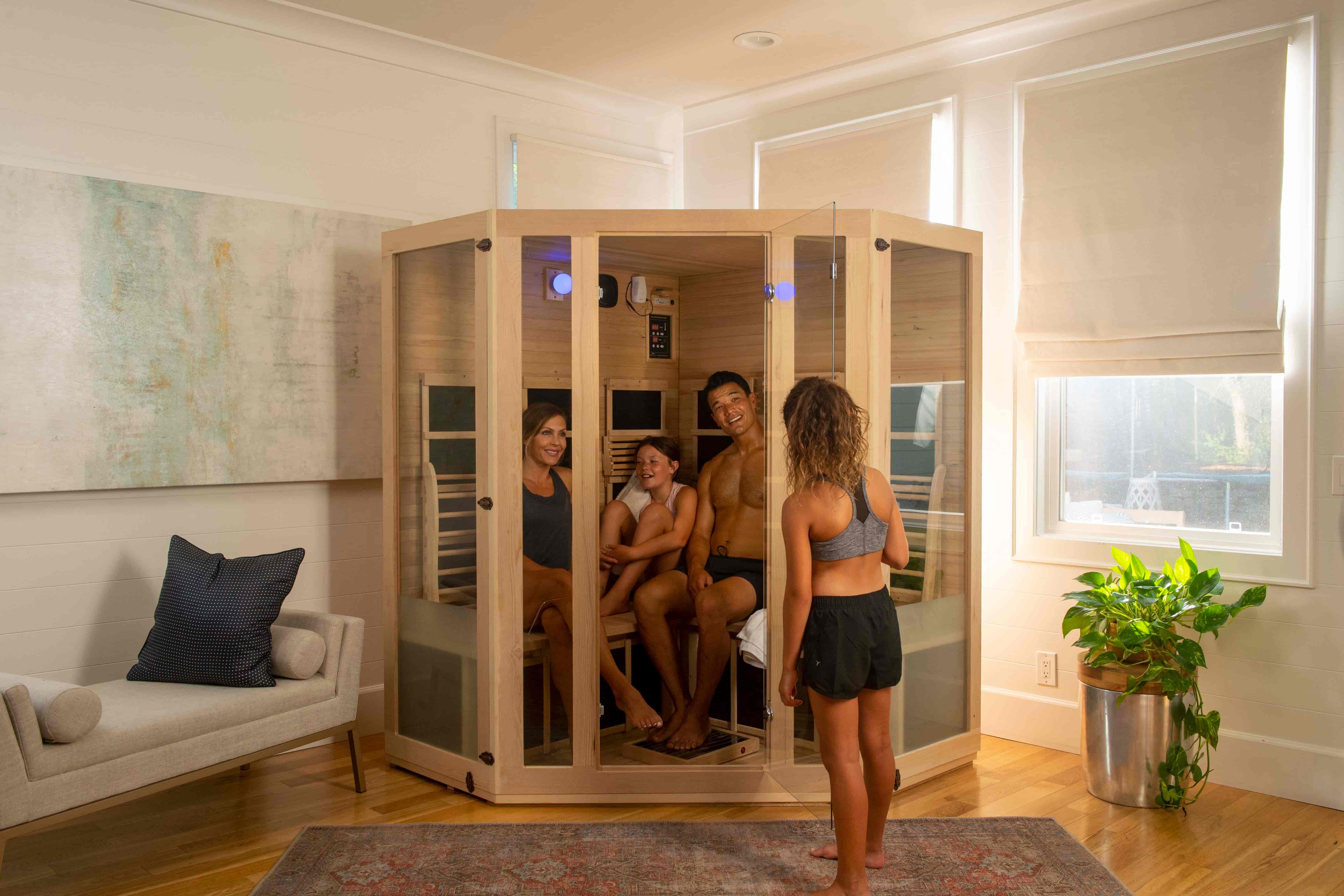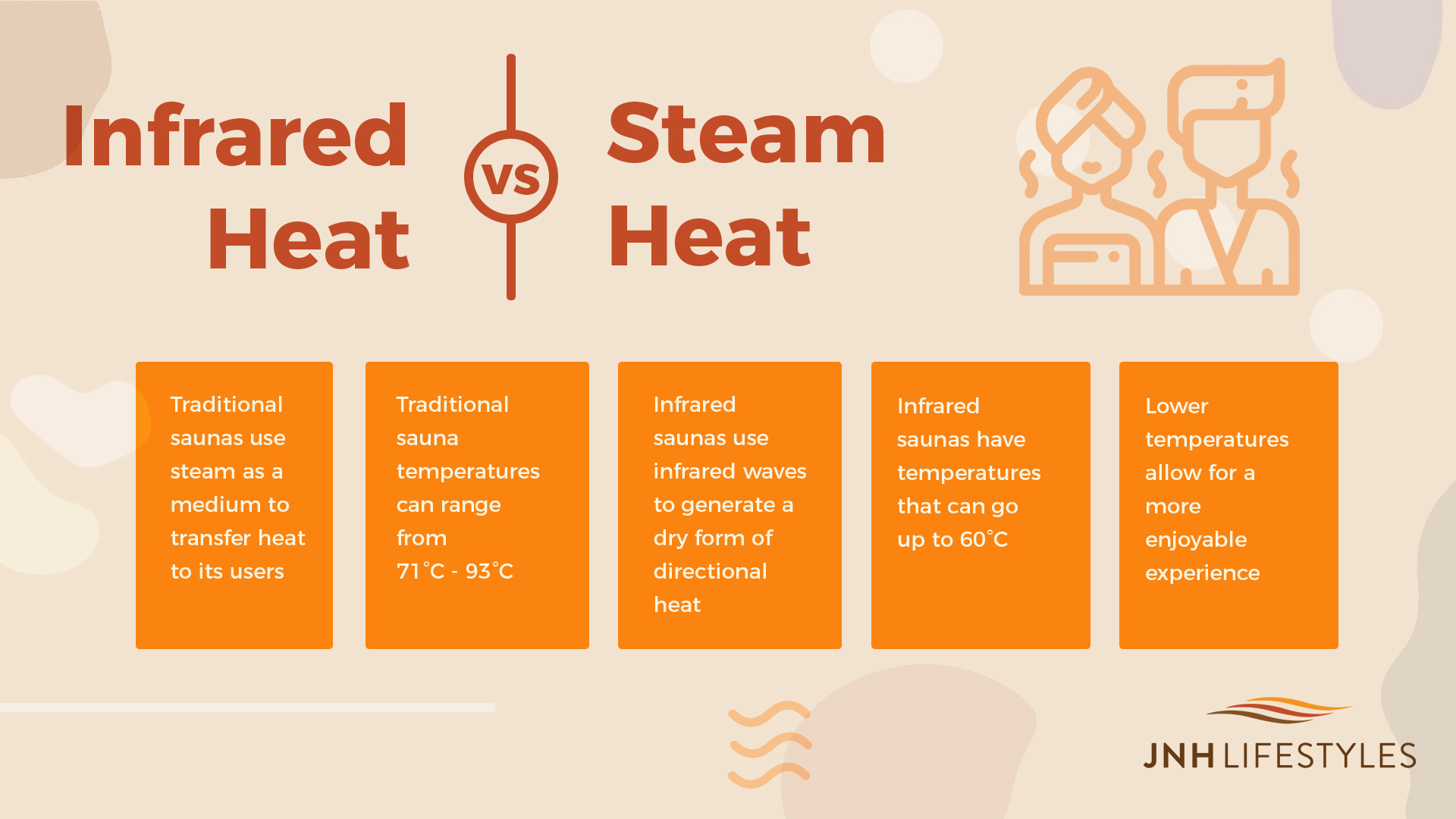Benefits of Far Infrared Sauna vs. Traditional
Not all saunas are the same. Although they’re based on the same principle of using heat to affect the body, their methods differ significantly. The most famous types are traditional saunas, which are equipped with wooden walls and a heat source. The important characteristic here is the heated rocks users pour water over to create steam. This can raise humidity in the booth and make the air stuffy and hard to breathe for long.
Infrared saunas use different methodologies to raise body temperature. Their infrared light heats the body from the inside without raising the temperature in the cabin to uncomfortable levels. Because of this, a person feels more comfortable staying inside for the recommended 30–40 minutes per session. Despite that, both types of saunas have benefits for physical and mental health, but the question is which one is more efficient and safer. Let’s have a look!
Positive Effects Of A Traditional Sauna
For 10,000 years, people have used the traditional Finnish sauna. Such saunas looked nothing like the ones we have today, but the idea was the same: expose the body to heat in an enclosed space. Back then, it was an earth pit covered with animal hide. Now, it's a room made of wood, furnished with comfortable space to sit and lie down, and water infused with aromatic oils to splash over hot rocks. The temperature inside a traditional sauna ranges from 160°F to 200°F. Every time a user pours water over the rocks, this temperature rises, along with the humidity.
Because of the intense, atmospheric heat, the body warms up and starts to sweat profusely. This will free your body from excess sodium, retained water, and dirt from your pores. One 30-minute session inside a traditional sauna can boost the immune system and lower levels of the stress hormone — cortisol [1]. Some studies show that a traditional sauna can help patients with Alzheimer's disease and dementia [2]. Because of the increased humidity and essential oils, some respiratory conditions may improve, like pneumonia for example [3].
When exposed to heat, blood vessels expand and the heart rate increases, which can contribute to the distribution of nutrients and oxygen to organs. Time spent inside a Finnish sauna had positive effects on arterial stiffness and high blood pressure, improving the outcome in patients with high cardiovascular risk [4]. Because of its natural environment thanks to wood, stones and scents, the ambient inside is calming and soothing, helping the body relax and relieve stress.
The Benefits Of An Infrared Sauna
All these health benefits from the traditional sauna [5] are something you can also get with infrared therapy, also known as an infrared sauna. This technologically advanced type of sauna can also be made out of quality wood, like JNH Lifestyles’ Freedom Collection, making it visually resemble the traditional one. This makes it an ideal spot to decompress in after a stressful day or simply gather your thoughts and clear your head.

Just like with a traditional sauna, infrared saunas also provoke intense perspiration, but at a lower level of heat. As mentioned before, traditional saunas reach temperatures of up to 200°F, but infrared saunas only require 140°F, enabling the user to achieve prolonged sessions. Infrared saunas can remove impurities from your pores [6] and open them up, so skin products are more efficient when applied afterward. Because infrared waves penetrate deeper into the skin deeper than traditional atmospheric heat, it can affect the body on the cellular level, leading to healing and a reduction of wrinkles. Additionally, frequent infrared therapy can lead to enhanced production of collagen and elastin, which also play an important role in the firmness and aging of skin [7].
Infrared saunas can also help you burn more calories if you pair them up with your exercise plan or other physical activity [8]. If you are an athlete or someone who works out regularly, an infrared sauna session may help with muscle ache, joint pain and injury healing [9]. It can also have the same health benefits for patients suffering from fibromyalgia and other musculoskeletal diseases. If you need to build your endurance, regular visits inside an infrared sauna may help you to continue playing sports and achieve great results [10].
The Bottom Line?
It’s a tough call to decide who can have more benefits — an infrared or traditional sauna. They can both be a valuable resource to enhance physical health and boost your mood. The main difference is in the method of developing heat and the way they affect the body.
Many people find traditional saunas hard to withstand because of the increased humidity and stuffy air. Although some respiratory patients may feel better, others may need to exit the booth after a few minutes because of breathing difficulties. With an infrared sauna, this is not an issue. The air in the booth can get only slightly above the norm since the infrared light increases the temperature of the body and less of the surrounding air.
Another plus side to an infrared sauna is the convenience. You don't have to get out of the house to enjoy all the benefits of an infrared sauna since you can install it anywhere in your home. They vary in size, type and wooden materials used for their construction, making them more versatile than traditional saunas. Concerning expenses, you will pay a lot less to have an infrared sauna in your home than what you'd pay on renovating and remodeling to build a traditional sauna into your home.
While they are both charming and useful ways to improve your health, it's best to go with an infrared sauna. It has similar benefits as a traditional sauna, with some new characteristics that will certainly make it more beneficial.

Resources:
[1]Pilch, W, et al. (2013). “Effect of a Single Finnish Sauna Session on White Blood Cell Profile and Cortisol Levels in Athletes and Non-Athletes.” ncbi.nlm.nih.gov, The National Center for Biotechnology Information, December 2013, https://www.ncbi.nlm.nih.gov/pmc/articles/PMC3916915/.
[2]Laukkanen, T, et al. (2016). “Sauna bathing is inversely associated with dementia and Alzheimer's disease in middle-aged Finnish men.” academic.oup.com, Oxford Academic, December 2016, https://academic.oup.com/ageing/article/46/2/245/2654230.
[3]Kunutsor S.K, et al. (2017). “Frequent sauna bathing may reduce the risk of pneumonia in middle-aged Caucasian men: The KIHD prospective cohort study.” sciencedirect.com, Science Direct, November 2017, https://www.sciencedirect.com/science/article/pii/S0954611117303578.
[4]Laukkanen, T, et al. (2017). “Acute effects of sauna bathing on cardiovascular function.” nature.com, Journal of Human Hypertension, December 2017, https://www.nature.com/articles/s41371-017-0008-z.
[5]Hussain, J and Cohen, M. (2018). “Clinical Effects of Regular Dry Sauna Bathing: A Systematic Review.” ncbi.nlm.nih.gov, The National Center for Biotechnology Information, April 2018, https://www.ncbi.nlm.nih.gov/pmc/articles/PMC5941775/.
[6] Cohn JR, Emmett. (1978). “The excretion of trace metals in human sweat”. ncbi.nlm.nih.gov, National Center for Biotechnology Information, July–August 1978, https://www.ncbi.nlm.nih.gov/pubmed/686643.
[7] Wunsch, A and Matuschka, K. (2014). “A Controlled Trial to Determine the Efficacy of Red and Near-Infrared Light Treatment in Patient Satisfaction, Reduction of Fine Lines, Wrinkles, Skin Roughness, and Intradermal Collagen Density Increase.” ncbi.nlm.nih.gov, National Center for Biotechnology Information, February 2014, https://www.ncbi.nlm.nih.gov/pmc/articles/PMC3926176/.
[8] Kim, Sungwoon, et al. (2017). “Does treadmill walking with near-infrared light applied to the abdominal area reduce local adiposity and body weight?” ncbi.nlm.nih.gov, National Center for Biotechnology Information, October 2017, https://www.ncbi.nlm.nih.gov/pmc/articles/PMC5684004/.
[9] Gale, George D,et al. (2006). “Infrared therapy for chronic low back pain: A randomized, controlled trial.” ncbi.nlm.nih.gov, National Center for Biotechnology Information, 2006, https://www.ncbi.nlm.nih.gov/pmc/articles/PMC2539004/.
[10] Mero, Antti, et al. (2015). “Effects of far-infrared sauna bathing on recovery from strength and endurance training sessions in men.” ncbi.nlm.nih.gov, National Center for Biotechnology Information, July 2015, https://www.ncbi.nlm.nih.gov/pmc/articles/PMC4493260/.

